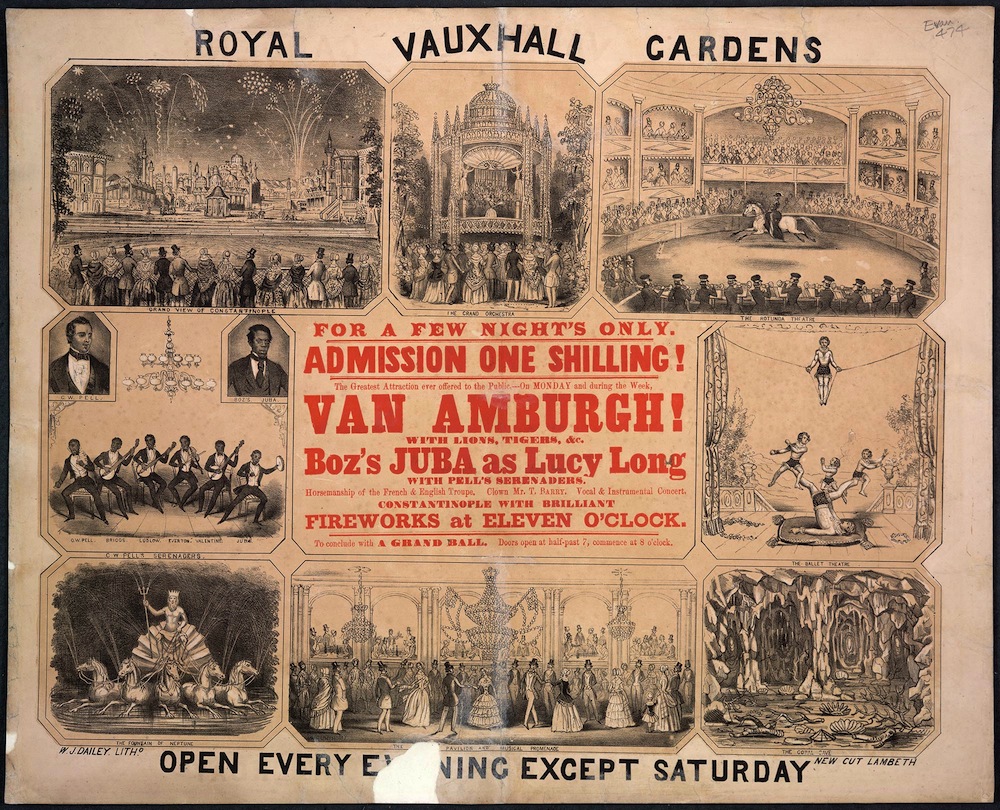[Click the back button on your web browser to return to the section of “Signs of the Times” for which the following serves as an annotation.]

"Royal Vauxhall Gardens. For a few nights only. Admission one shilling! The greatest attraction ever offered to the public." Estimated date, 1841. British Library shelfmark: Evan. 474 (in public domain). [Click on the image to enlarge it.]
Vauxhall: Situated in London on the south bank of the River Thames, Vauxhall Gardens was a pleasure garden considered to be one of the most popular venues for public entertainment between the mid-seventeenth and mid-nineteenth century. It consisted of many acres of trees and shrubs as well as long, allegedly romantic, walks. Originally named New Spring Gardens, admission was free, but when in 1785 it was renamed Vauxhall Gardens an entrance fee was charged and the money used to gain its numerous attractions. Famous for its spectacular firework exhibitions, it supported enormous crowds and provided other entertainment such as tightrope walkers, concerts and hot air balloon ascents. The poster seen above is from the closing decades of the garden, but, as the British Library commentary on it points out, "it shows that lavish evening entertainments were still common." As well as fireworks and acrobatic displays, it advertises spectacular scenes; horsemanship displays; its very own illuminated Neptune's Fountain; dances; musical entertainments (including C. W. Pell's (black) Serenaders; and a "coral cave" in the lower right-hand corner. After going into bankruptcy seven times in the following years, the whole enterprise finally closed in 1859.
“Signs of the Times” mourns the loss of the spiritual in favour of the mechanical, which has become so extreme that even the scientific works of those such as Hartley, Darwin, and Priestly are disregarded in favour of the metaphysical philosophy of men such as the French philosopher, Dr. Pierre Cabanis, who “fairly lays open our moral structure with his dissecting-knives and real metal probes; and exhibits it to the inspection of mankind.” Carlyle considers his approach to such an emotional, vibrant subject, “the land of wonders,” far too sterilised and mechanical. He likens his emotionless examination of life to a man who walks with “scientific stoicism” through Vauxhall Gardens, seeing all the wonderful amusements and scenery as something for “the vulgar” and noticing not the delight and beauty of them, but the unattractive materials and items such as “saltpetre, pasteboard and catgut” used to create them.
Bibliography
Cannon, J A. "Vauxhall Gardens." Encycopedia.com. Web. Viewed 5 April 2010.
Coke, David "Brief History." Vauxhall Gardens 1661-1859. Web. Viewed 5 April 2010.
"The Royal Vauxhall Gardens." British Library. Web. Viewed 25 July 2016.
"Vauxhall Gardens." Wikipedia. Web. Viewed 5 April 2010.
JB added British LIbrary image and information, 25 July 2016